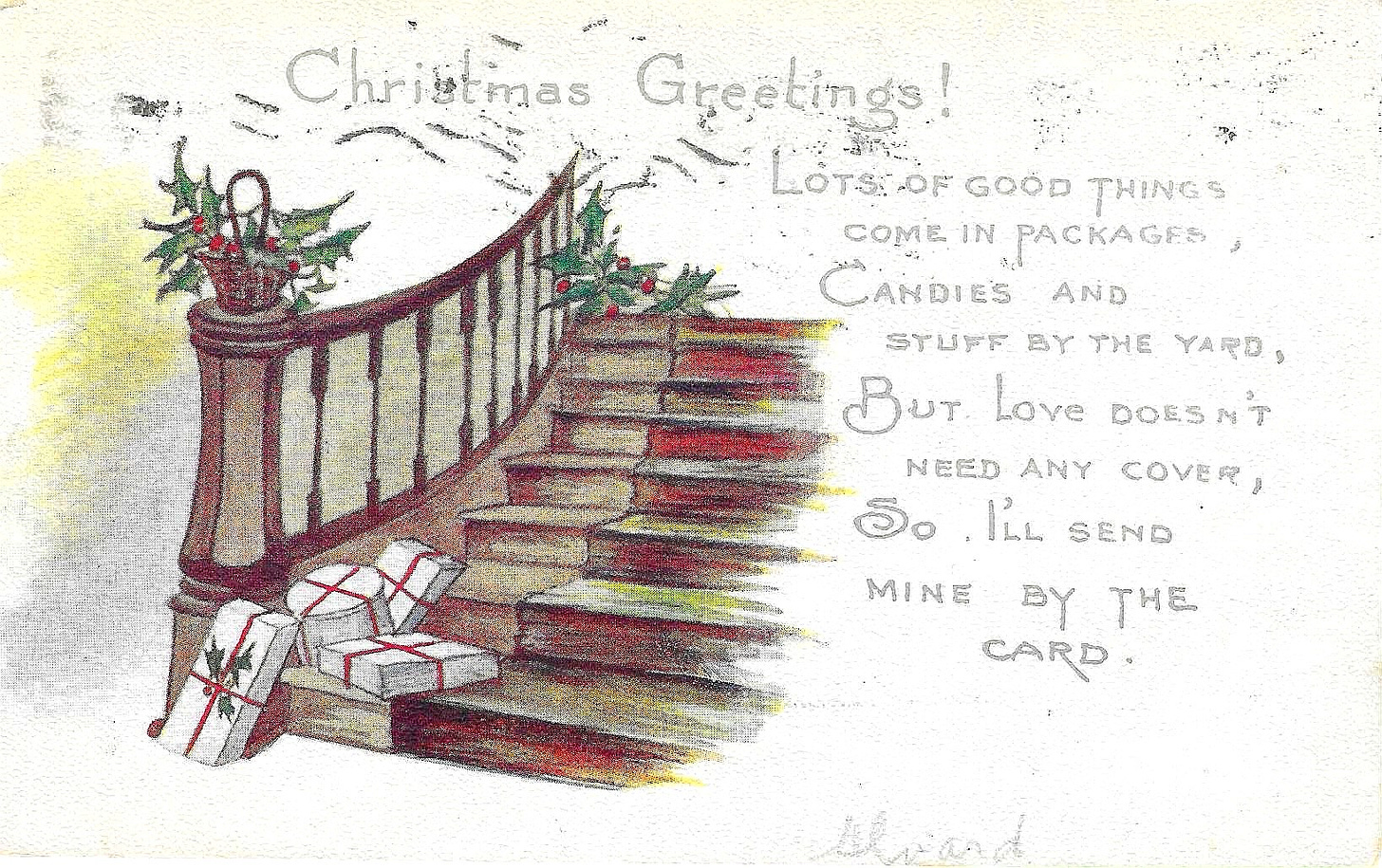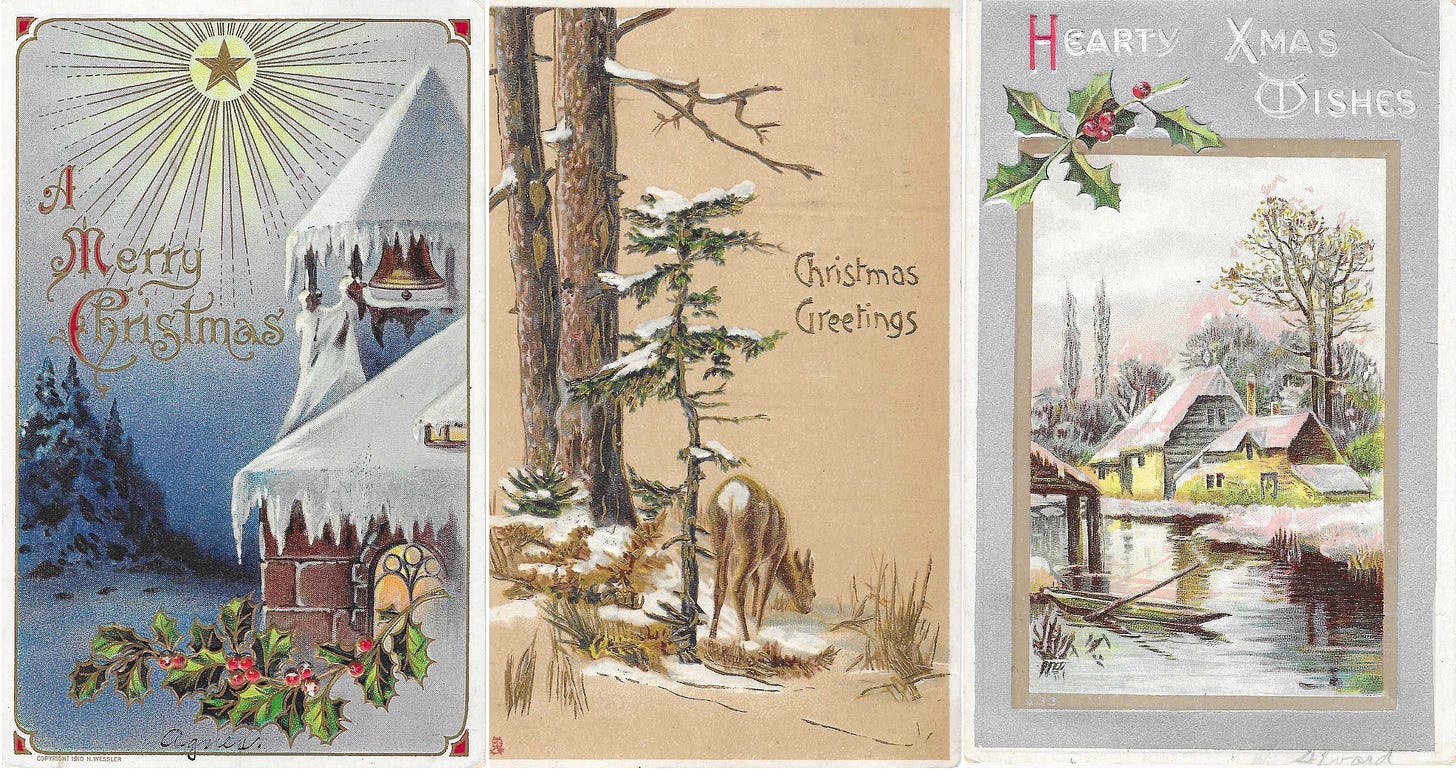Welcome to a new section of My Plastic Camera: Ephemera. Somewhere between an essay and a history — I suppose you could call it a little Cabinet of Curiosities. I am planning for this to be a monthly section that will be a bit lighthearted, sometimes strange, random, and intriguing. Ephemera will focus on objets trouvés, collections, connections, old-fashioned things…things that have a unique beauty and a story to tell. Enjoy!

Hello, I’m Annie, and I’m a deltiologist. A deltiologist is a collector of postcards (at least according to the Smithsonian.) I’ve collected postcards since I was young, obsessing over the scalloped-edges, vacation fonts, and multiple views of an exotic locale that could all be held in the hand. I thought they were portals to another, much more colorful, more beautiful dimension than the one I was in. Postcards are escapism incarnate. In college, I studied under painter Wayne Thiebaud at UC Davis. In Art 148 - Wayne’s Theory and Criticism class, he encouraged all of us to collect postcards, especially of works of art. I still pick up a few art postcards in whatever museum I’m visiting — they’re exact, meticulously produced from high resolution scans, and as near to the real thing as you can get for about a dollar. From this, I never really stopped collecting.
When I lived in Paris in college, I started to collect vintage postcards of Paris, which served as a gateway drug to vintage postcards from everywhere. My escapism never ends. Some of these Parisian scenes are the oldest ones I have, even with a few featuring the postage stamp stuck to the image side because originally you could not put ANYTHING on the address side of the card except for the address. That changed within a few years, but writing more than the address on the card was discouraged for a long time. Often the only greeting was a signature or a single line. This practice went on for a lot longer.
I was looking for something the other day and came across some old Christmas postcards that seem to be dated from about 1900-1930 or so, and I think they’re a kick. Not only are they written with sweet, little holiday greetings, most of them were sent in a time before zip codes or street numbers. Even the cards themselves have no copyright or printer’s mark except for four: International Art Publishing Company of New York; Gibson Art Company of Cincinnati, OH; Owen Card Publishing Company of Elmira, NY; Raphael Tuck & Sons of London, complete with their royal warrant stamped in the margin. Of all of these, Raphael Tuck, or “Tuck’s” as it was most commonly called, has the richest history, even as its archives were destroyed during the London Blitz. The International Art Publishing Company is also the most well-known in America, but both Gibson and Owen are a mystery.
Although illustrated in-house, most of the printing of these cards was done in Germany, and often featured metallic foils, glossy or burnished finishes, embossing, debossing, and meticulous coloration. The thing that caught my attention this time was the very distinct themes of the illustrations. Obviously these were mass-produced and designed to be popular, not to mention centered on Christian imagery, but from my limited collection there’s just a few motifs throughout: poinsettias, holly, bells, verses or poetry, and snow scenes.
Let’s consider the bells. Bells are a Christmas classic, and not just because of the Hershey Kisses ad. Bells are traditionally rung to herald good news or let people know its time to go to church. In the dark of winter you can still hear bells, so I suppose they also symbolize hope. After all, Scrooge knew his long night was over when he heard the Christmas bells in the morning. These bells are simple but luxurious. They gleam and shine, and have a touch of either holly or mistletoe, and let’s scroll a little ribbon in there too. (The one on the right has metallic foil over it that is now flaking away, which has mostly been lost on the holly.) Other than a little spring of green, and four lines of verse, these bells are pure and hold their own.

Other than the bells, the most pure motif of the cards is that of the snowy scene on a winter night. These stand on their own and they’re simple and beautiful. These seem to be a combination of a haven in the cold night, plus a bit of the beauty of a snowy winter. They’re romantic and evocative — you can even feel the cold between your shoulder blades.
After these though, the motifs cross-mutate. Usually it’s a combination of poinsettia or holly with a snow scene, and usually the snow scene is done as a framed inset. Sometimes there’s even a touch of poetry. I’m only calling out the pattern, because there’s so many of them that they must have been a solid money maker over the years.
You don’t see a lot of holly at Christmas any more and the only reason I can think why is because it’s prickly and sharp and not pleasant to deal with. It’s still beautiful though — glossy evergreen with bright red berries even in the snow. Therefore, it’s a symbol of hope in darkness of the cold months, and also eternal life.
The big floppy poinsettia. I’m not sure why' they’re so full of droop in these illustrations, but I suppose they are a difficult flower to render. This set is really pretty hokey when you look at the inset images of snowy farms. Unlike the large snow scenes, or even the dainty ones above with the holly, these seem heavy. They don’t tell any story or even look particularly appealing, but you get the overall effect. The bottom right has them framed in a sort of golden shield(?) and supported by holly too which is so bizarre. I do love the font though.
Now we have snowy scenes combined with verse or little poems. These are spare and sweet, but clearly less lush than the others. I love this Kriss Kringle poem at top left because while I know they’re out there, I don’t have any Santas in my collection except for this one. This one almost looks a little Vienna Secessionist to me — almost like a woodblock print. The other three have their dainty little scenes that seem to simply melt out of the white of card into another space. This allows enough room for the “thought” or greeting that is clearly the main event.
These last three are essentially different from the rest. I adore this image of the magi looking at the star in the desert — the colors are so lush and the scene is beautifully detailed. I even love the way the image edge is intentionally jagged so it looks aged. I also love a stocking, and I cannot imagine why there aren’t MORE stockings in these cards. I also think this is the first candy cane we’ve seen, which is hard to believe. I love candy canes! They aren’t my favorite thing to eat, but I love their fun stripes and visual interest. The holly wreath is back (we’ve seen it a few times above) and that is definitely something you don’t see these days. I also wanted to end with this more contemporary postcard of the famous Christmas Tree Lane in Pasadena, CA. This is actually in Altadena (just north of Pasadena), and it still lights up every Christmas.
Within just a few decades, the Christmas postcards were essentially supplanted by more formal greeting cards, and then photo cards. I love receiving photo cards from friends — I love seeing families, and honestly I wouldn’t ever see some of my friends’ kids if it weren’t for these cards. That said, I love a beautiful holiday illustration on a card. They aren’t as popular for sure, and yes, they do get expensive, but I love them. Maybe the solution would be to bring back Christmas postcards? Just a thought…










This is simply delightful. Vintage ephemera forever ♥️